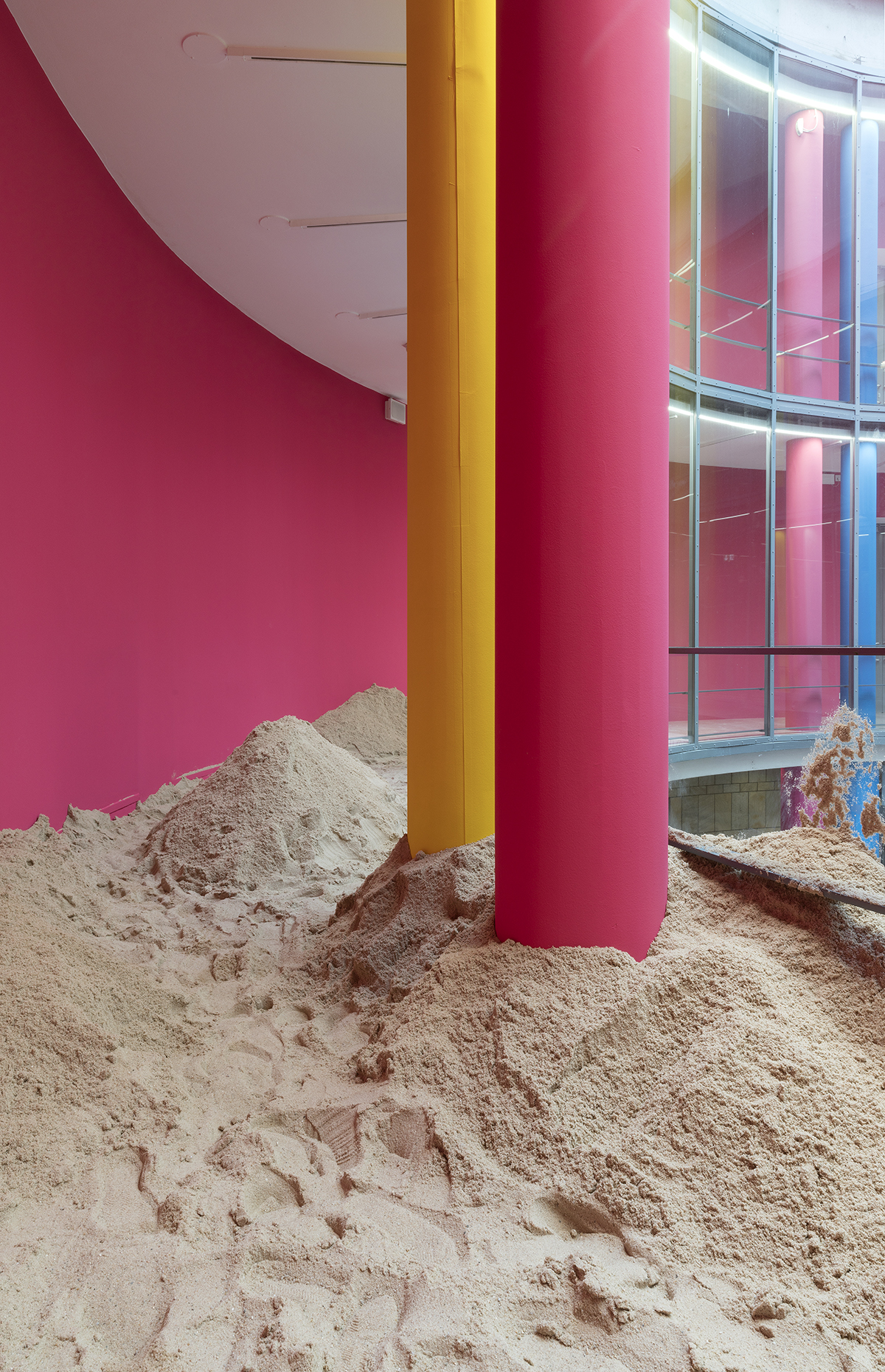Lena Henke, “Don’t shout at me, Warrior!” at Schirn Kunsthalle

For her work Don’t shout at me, Warrior! at the Schirn, Lena Henke added elements of divergent severity to the museum’s architecture. They are not so much site-specific as site-implicit. By this I mean, they aren’t simply reacting to the body which they are colonizing. Rather, they act upon the building and its meaning to such a degree that the additions make use of the host structure and channel alternative meaning through it. This lets the viewer encounter a freshly built body and reflect on its possibilities. While some elements are as heavy as the word “sculpture” itself, others are fugitive, literally passing through the building. And like that, the artist both claims the institution’s territory and challenges the institutional authority of sculpture. Her stage and place of action are one and the same: the rotunda, a public space to pass through the museum without having to enter it. Through its implications, the work halts the stream of passersby and interrupts their passage. The rotunda’s facade is colored—in homage to architect Luis Barragán—in signals of pink, blue, and yellow. On the opposing entrances, Henke placed two oval-shaped aluminum boxes. In a gesture a bit like shrugging one’s shoulders, the aluminum echoes the objectness of Donald Judd’s art, and by blocking everyone’s path, the boxes caricature Minimalism’s emphasis on the relationship between the object and its viewer. This would seem, weirdly enough, like a nostalgic move, but at the same time, the artist refuses Minimalism’s geometry and adherence to abstraction.

Seen from above, the aluminum objects reveal elegantly drawn eyes, pointing their stare past the museum, skyward. As with Minimal art, it isn’t clear whether one’s looking at the eye or whether it is the eye, which is glancing back. By not only representing a human perspective but suggesting a viewpoint of the object itself, Henke harks back to a variety of ideas (including Eva Hesse) and considers the work’s material makeup and its animistic potential. Minimalism’s celebration of industrial processes today stands as a burden of a previous generation. By calling out this romanticism and exposing it as a farce, the artist turns this dated position into a superficial relic, which opposes the most pressing issues of the post-industrial age (ecology, labor conditions of the masses, etc.). Henke decidedly wants us to stop and take a look, precisely feeling out a multiplicity of contingencies. By applying Ad Rheinhardt’s thought that “the eye is a menace to clear sight” and inverting his claim that “art begins with the getting rid of nature,” she reminds us of sculpture’s historic potentiality and makes us doubt its massive assertiveness. For Henke, it is exactly the nature of things, who owns them, who is granted to access them, and where they belong, which constitutes her work. In a repeated back and forth, recalling the forces of gravity, materials are juxtaposed and played against one another, only to settle in a somewhat crooked equilibrium. The content relates to public space through its architecture and includes the artist’s personal experience and circumstance. The artist balances experience, knowledge, and wit, considering her topics in all seriousness, sometimes in awe, while she circumvents their standing, by obscuring or misusing their form. In the process, she disperses meaning and discharges the status of her references.

To what end? That remains to be seen. The aforementioned double mode of appreciation and disregard heavily recurs in Henke’s practice. While she commemorates her motifs and subjects, she faces them tongue-in-cheek, pulling the leg of the concept of sanctity and how things hold their place in history. In the stories above each eye, piles of sand sit around like playing or breeding grounds, and the windows in front of them are removed and replaced with rolling grilles. This draws a connection between the fancy shop windows in the neighborhood—which use the same grilles, not only to protect their goods, but also to parade the locked-up value of things—and the museum and its holdings.
Henke highlights the affinity between cultural heritage and the market, and how cultural value ultimately always becomes commodifiable. Every now and then, scoops of sand rain down into one of the gazing aluminum eyes, which stand right below, kicked down by a visitor or through child’s play. The little beaches of sand extend the metaphorical scope of the eyes by figuratively blinding them or switching on their dreams. The sculptures become unhinged as supposedly autonomous objects of art and are returned to bare functionality. They are forced to function as collecting containers, a refuge for detritus. The process hides and conserves the messy sand, a material used in bronze casting, within its opaque shell, which also covers up any requestion for an oh-so abstract insinuation of a measurement of time. Doing away with the heritage of our modern, patriarchal, capitalist art history, Henke must be aware that she is concurrently raising her own status, and how she eventually must be confronted with the—teasingly attractive—exigence to circumvent, disperse, and dismantle her own achievement. Does the sand remain on the ground once it is spilled? I guess it is more interesting to make a statement than to prove one’s point. Why should it be the artist’s job to conclude the cycle she has set in motion? After all, Don’t shout at me, warrior! isn’t a battle cry, but rather an invitation to shut up and have a look.

Tenzing Barshee is an independent curator and writer. Recently he organized the exhibitions “Namedropping” at Jan Kaps in Cologne, “Solo Cose Belle” at Galleria Acappella in Naples, and “Der Verdienst. 2014-2017” at Oracle in Berlin. His serial novel “Pine” is published in Starship magazine.